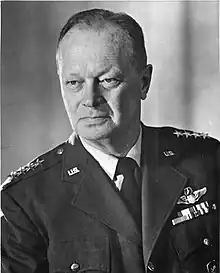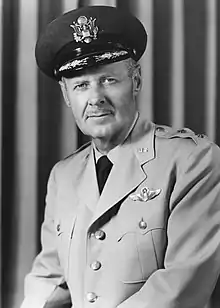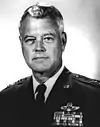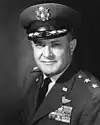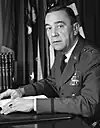| United States Air Forces Southern Command | |
|---|---|
 USAF Southern Command emblem | |
| Active | 20 November 1940 – 1 January 1976 (35 years, 1 month) Detailed
|
| Country | |
| Branch | |
| Type | Major Command |
| Garrison/HQ | Howard Air Force Base, Panama |
| Engagements | World War II - Antisubmarine |
| Commanders | |
| Notable commanders | Hubert R. Harmon |
The United States Air Forces Southern Command is an inactive Major Command of the United States Air Force. It was headquartered at Albrook Air Force Base, Canal Zone, being inactivated on 1 January 1976.
Initially designated Panama Canal Air Force when first established in October 1940, its mission was the defense of the Panama Canal. Later it took on United States Air Force relations, including foreign military sales (FMS) and disaster relief assistance, with the Latin American nations. The command supported disaster relief to countries such as Guatemala, Jamaica, Nicaragua, the Dominican Republic, Panama and Colombia. It also assisted states in Central and South America in purchases of United States military aircraft and trained their technicians in logistics and maintenance for the aircraft.
History
Pre-World War II activities
.jpg.webp)
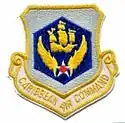
The first United States air units arrived in the Canal Zone in February 1917, with the 7th Aero Squadron being organized on 29 March at Ancon. It was equipped with Curtiss JN-4 "Jennys" and Curtiss R-3 and R-4 floatplanes.
The squadron initially came under the control of Headquarters, U.S. Troops, Panama Canal Zone, and beginning on 1 July 1917, Army aviation units were assigned directly to the Panama Canal Department, which was the controlling United States Army headquarters in the Canal Zone. During World War I, the 7th Aero was assigned to patrol for German U-boats offshore of the Canal Zone under direction of Coast Defenses of Cristobal, from 1 June – 15 November 1918.
The 7th Aero Squadron was assigned to several fields during 1917 and 1918, those being Corozal (16 April); Empire (May); Fort Sherman (29 August); Cristobal (March 1918) before finding a permanent home at Coco Walk, which became France Field in May 1918.
A second permanent army airfield, Albrook Field, opened in 1932 due to France Field becoming too small for the numbers of aircraft being assigned to the Canal Zone, as well as having a poor landing surface; offering no room for expansion, and providing little defense for the Pacific entrance to the Panama Canal. A third airfield, Howard Field was built on the Canal Bruja Point Military Reservation, opening on 1 December 1939. By 1940, a rapid increase in the number of flying squadrons in both the Canal Zone as well as in Panama as a result of the pre–World War II mobilization of the Air Corps warranted a new organization, and the Panama Canal Air Force was created as a major command. After several organizational changes and the establishment of the United States Army Air Forces in 1942, Sixth Air Force became the controlling Air Force command authority for USAAF activities in the Caribbean, as well as in Central and South America. Through all these redesignations it was part of the Caribbean Defense Command, (10 February 1941 – 1 November 1947), which was the senior United States Army headquarters in the Canal Zone. The Caribbean Interceptor Command, was the Air Force component (10 February 1941 – 17 October 1941) of the CIC until being inactivated and replaced by VI Interceptor Command.
World War II


In early 1942 the Nazi Germany's Kriegsmarine, began anti-shipping operations using U-boats in the Caribbean. The subs sank several tankers in the harbor at Sint Nicholaas, Aruba and even shelled an oil refinery on the island. The refineries at the island of Aruba and Curaçao possessed oil from wells in Venezuela, and accounted for one-third of the Allies' supply of gasoline.
The first wartime mission of the newly created Sixth Air Force was to perform antisubmarine operations in the Caribbean and the Gulf of Mexico areas and to cover Allied shipping convoys in the area. The Sixth Air Force expanded throughout the Caribbean and Latin America, stationing units from Cuba in the north to British Guiana and Surinam on the northern coast of South America to protect the Venezuelan oilfields. Air bases were established along the western coast of South America, in Peru, Ecuador as well as in the Galápagos Islands, Panama, Guatemala and Costa Rica.[1] In order to protect the vital Air Transport Command South Atlantic Air Route to Europe and North Africa, Sixth Air Force combat units were stationed in Brazil to patrol the South Atlantic air routes.
Sixth Air Force had the responsibility for tracking down submarine wolfpacks, which consisted of groups of three of more subs attacking Allied shipping using a strategy now known as "Search and Destroy". As most shipping in the Caribbean was not in defensive convoys, aerial surveillance of the area was crucial to their safety. However, in the fall of 1942 the German Navy changed tactics and reduced their submarine activity in the Caribbean region to concentrate its activity on the North Atlantic convoy route and the approaches to northwest Africa. With the withdrawal of submarines from the Caribbean region the Sixth Air Force concentrated its efforts as a striking force on its primary function of guarding against possible attacks on the Panama Canal.
Post-war mission
With the end of the war, most of the wartime Caribbean air bases used for antisubmarine patrols were returned to civil authorities in late 1945 or early 1946. The Lend-Lease air bases from Great Britain, which were on 99-year leases were reduced to skeleton units and used largely as MATS weather stations. They were all closed for budgetary reasons in 1949.
The postwar Sixth Air Force, redesignated Caribbean Air Command as part of the 1946 USAAF reorganization, and its successor units returned to its prewar mission, the defense of the Panama Canal; support for friendly Latin American air forces, and to provide support to Latin American nations engaged in anti-communist activities during the Cold War. Howard Air Force Base became a focus for military air support, with many surplus USAF aircraft being transferred to Latin American air forces there, as well as the establishment of the Inter-American Air Forces Academy, which provided technical training and education for airmen and officers from approximately 14 Latin American countries.
In the post Vietnam War drawdown of the USAF, the United States Air Forces Southern Command was inactivated in 1976 for budgetary reasons. Most of its functions and resources passed to the Tactical Air Command, which established the USAF Southern Air Division (later 830th Air Division; Air Forces Panama) as the USAF component of the United States Armed Forces in the Panama Canal Zone.
Lineage
- Established as Panama Canal Air Force on 19 October 1940
- Activated as a Major Command on 20 November 1940
- Redesignated as Caribbean Air Force on 5 August 1941
- Redesignated as 6th Air Force on 18 September 1942
- Redesignated as Caribbean Air Command on 31 July 1946
- Redesignated as United States Air Forces Southern Command on 8 July 1963
- Inactivated as a Major Command on 1 January 1976
Units assigned
|
|
Stations
- Permanent
- Albrook Air Force Station, Canal Zone, 1932–1976
- France Air Force Base, Canal Zone, 1917–1949
- Howard Air Force Base, Canal Zone, 1939–1976
- Rio Hato Army Air Base, Panama, 1931–1948
- Borinquen (later Ramey) Air Force Base, Puerto Rico, 1936–1971
- (Assigned to Strategic Air Command, 26 May 1949)
- Wartime/Lend-Lease
|
|
List of commanders
| No. | Commander[2][3] | Term | |||
|---|---|---|---|---|---|
| Portrait | Name | Took office | Left office | Term length | |
| 1 | Major General Frank M. Andrews | 6 December 1940 | 19 September 1941 | 287 days | |
| 2 | Major General Davenport Johnson | 19 September 1941 | 23 November 1942 | 1 year, 65 days | |
| 3 | Major General Hubert R. Harmon | 23 November 1942 | 8 November 1943 | 350 days | |
| 4 | Brigadier General Ralph H. Wooten | 8 November 1943 | 16 May 1944 | 190 days | |
| 5 | Brigadier General Edgar P. Sorensen | 16 May 1944 | 21 September 1944 | 128 days | |
| 6 | Major General William O. Butler | 21 September 1944 | 24 July 1945 | 306 days | |
| 7 | Brigadier General Earl H. DeFord | 24 July 1945 | 1 February 1946 | 192 days | |
| 8 | Major General Hubert R. Harmon | 1 February 1946 | 4 October 1947 | 1 year, 245 days | |
| - | Brigadier General Glen C. Jamison Acting | 4 October 1947 | 13 November 1947 | 40 days | |
| 9 | Major General Willis H. Hale | 13 November 1947 | 20 October 1949 | 1 year, 341 days | |
| 10 | Brigadier General Rosenham Beam | 20 October 1949 | 15 November 1950 | 1 year, 26 days | |
| 11 | Brigadier General Emil C. Kiel | 15 November 1950 | 11 June 1953 | 2 years, 208 days | |
| 12 | Major General Reuben C. Hood | 11 June 1953 | 20 June 1956 | 3 years, 9 days | |
| 13 | Major General Truman H. Landon | 20 June 1956 | 3 August 1959 | 3 years, 44 days | |
| 14 | Major General Leland S. Stranathan | 3 August 1959 | 11 September 1963 | 4 years, 39 days | |
| 15 | Major General Robert A. Breitweiser | 11 September 1963 | 6 August 1966 | 2 years, 329 days | |
| 16 | Major General Reginald J. Clizbe | 6 August 1966 | 14 June 1968 | 1 year, 313 days | |
| 17 | Major General Kenneth O. Sanborn | 14 June 1968 | 7 April 1972 | 3 years, 298 days | |
| 18 | Major General Arthur G. Salisbury | 7 April 1972 | October 1974 | c. 2 years, 191 days | |
| 19 | Major General James M. Breedlove | October 1974 | 1 January 1976 | c. 1 year, 78 days | |
References
![]() This article incorporates public domain material from the Air Force Historical Research Agency
This article incorporates public domain material from the Air Force Historical Research Agency
- ↑ Conaway, William. "VI Bombardment Command History". Planes and Pilots of World War Two.
- ↑ Maurer 1983, p. 462.
- ↑ "United States Air Forces Southern Command" (PDF). usafunithistory.com. 15 December 2010. Retrieved 6 September 2023.
- Maurer, Maurer, ed. (1983) [1961]. Air Force Combat Units of World War II (PDF) (reprint ed.). Washington, DC: Office of Air Force History. ISBN 0-912799-02-1. LCCN 61060979.
- Ravenstein, Charles A. (1984). Air Force Combat Wings, Lineage & Honors Histories 1947–1977 (PDF). Washington, DC: Office of Air Force History. ISBN 0-912799-12-9.
- ArmyAirForces.com
- "United States Air Forces Southern Command". Air Force Historical Research Agency. Archived from the original on 25 March 2009.
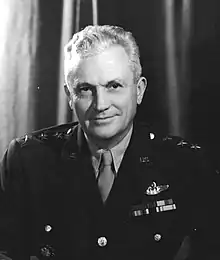
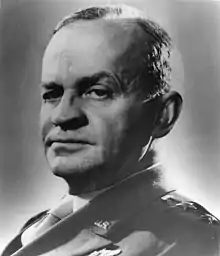
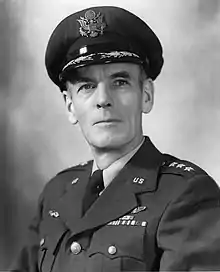
.jpg.webp)
.jpg.webp)
.jpg.webp)
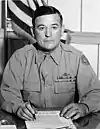
.jpg.webp)
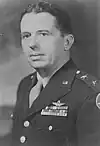
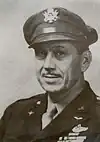
.jpg.webp)
.jpg.webp)
